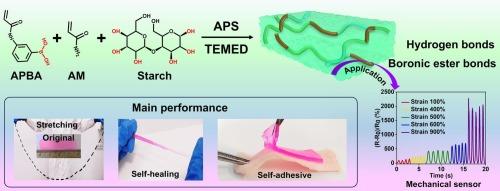设计基于淀粉的超伸展性、快速自愈合和自粘合水凝胶,用于可穿戴应变传感器
IF 10.7
1区 化学
Q1 CHEMISTRY, APPLIED
引用次数: 0
摘要
由于水凝胶具有导电性,易于工程化,并且具有足够的柔韧性,可以模仿人体皮肤的机械特性,因此被视为可穿戴应变传感器的潜在选择。然而,要通过简单直接的方法制备出集优异的拉伸性、离子传导性、韧性、自粘性和自愈合性于一体的水凝胶,仍然是一项巨大的挑战。在这里,丙烯酰胺/3-丙烯酰胺苯硼酸交联网络通过加入淀粉进行改性,只需一个简单的步骤就能制备出半互穿交联水凝胶。制备的水凝胶含有动态硼酸酯键和氢键,因此具有优异的拉伸性(5769-13976 %,20-50 wt%)、理想的透光率(90 %)、自粘性(0.636 ± 0.060 kPa,30 wt%)和自愈合特性。值得注意的是,自愈合过程可在瞬间完成,愈合强度高达 81.21%。此外,作为应变传感器,上述水凝胶还具有工作应变范围广(≈ 500 %)、灵敏度高(测量系数 = 1.99)的特点,可精确记录和跟踪人体动作。这项工作为合成具有最佳整体机械特性的水凝胶提供了一种新方法,有望促进基于水凝胶的可穿戴应变传感系统在现实世界中的应用。本文章由计算机程序翻译,如有差异,请以英文原文为准。

Design of super stretchability, rapid self-healing, and self-adhesion hydrogel based on starch for wearable strain sensors
Since hydrogels are conductive, easily engineered, and sufficiently flexible to imitate the mechanical properties of human skin, they are seen as potential options for wearable strain sensors. However, it is still a great challenge to prepare a hydrogel through simple and straightforward methods that integrate excellent stretchability, ionic conductivity, toughness, self-adhesion, and self-healing. Herein, an acrylamide/3-acrylamide phenylboronic acid cross-linked network is modified to produce a semi-interpenetrating cross-linked hydrogel in just one easy step by adding starch. The prepared hydrogel contains dynamic boronic ester bonds and hydrogen bonds, which endow the exceptional stretchability (5769–13,976 %, 20–50 wt%), ideal transmittance (>90 %), self-adhesiveness (0.636 ± 0.060 kPa, 30 wt%), and self-healing properties. Notably, the self-healing process is completed instantly, achieving a healing strength of up to 81.21 %. Additionally, the aforementioned hydrogel exhibits a broad working strain range (≈ 500 %) and high sensitivity (gauge factor = 1.99) as a strain sensor, allowing it to record and track human actions precisely. This work provides a novel approach to synthesizing hydrogels with optimal overall mechanical characteristics, with the potential to facilitate the development of wearable strain sensing system based on hydrogels for real-world applications.
求助全文
通过发布文献求助,成功后即可免费获取论文全文。
去求助
来源期刊

Carbohydrate Polymers
化学-高分子科学
CiteScore
22.40
自引率
8.00%
发文量
1286
审稿时长
47 days
期刊介绍:
Carbohydrate Polymers stands as a prominent journal in the glycoscience field, dedicated to exploring and harnessing the potential of polysaccharides with applications spanning bioenergy, bioplastics, biomaterials, biorefining, chemistry, drug delivery, food, health, nanotechnology, packaging, paper, pharmaceuticals, medicine, oil recovery, textiles, tissue engineering, wood, and various aspects of glycoscience.
The journal emphasizes the central role of well-characterized carbohydrate polymers, highlighting their significance as the primary focus rather than a peripheral topic. Each paper must prominently feature at least one named carbohydrate polymer, evident in both citation and title, with a commitment to innovative research that advances scientific knowledge.
 求助内容:
求助内容: 应助结果提醒方式:
应助结果提醒方式:


